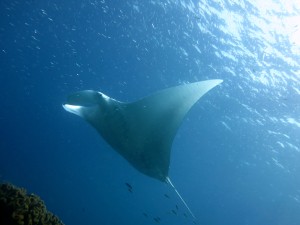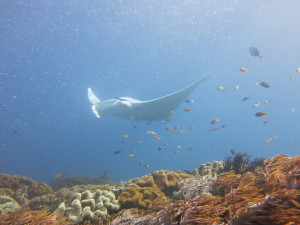At the end of last year I had the amazing opportunity to join an expedition team from The Nature Conservancy (TNC) to conduct a rapid ecological assessment of the Savu Sea Marine Protected Area. Between October 28 and November 15 we covered more than 1,000 nautical miles (1,800 km) and surveyed 55 out of a targeted 58 locations in the waters of the Savu Sea Marine Protected Area.
As the team’s Coral Reef Fish Specialist I helped develop a baseline assessment of the coastal habitats within the Savu Sea Marine Protected Area. I was in charge of surveying reef fish, assessing the community structure, and identifying the economically important reef fisheries in the area.
Our expedition was conducted onboard the Seven Seas, were we were joined by marine conservation expert Dr. Rodney V. Salm, Senior Advisor to TNC’s Indo-Pacific marine program. Dr. Salm has been planning and surveying marine conservation areas in Indonesia since the early 1980’s, and diving in Indonesia since 1973, well before I was born! It was so interesting to listen to his stories, and to learn how the marine environment has changed during this time.
Our surveys revealed that, in general, the coastal habitats of the Savu Sea Marine Protected Area are in good condition. We recorded high levels of coral cover and a rich benthic community structure, with high fish biomass and diversity. At several sites we saw sharks, bumphead parrotfish, Napoleon wrasse, snappers and groupers. We found surgeonfish are almost every site, and at one site near Batek Island, East Timor we observed hundreds of big eye trevally schooling in a strong down current. It was such an impressive sight, but also a little scary!
We even saw three blue whales during the expedition, emphasizing the importance of the Savu Sea as a migratory corridor for the largest animals on earth.
But there was one aspect of this trip that I will always remember. Despite the fact that I am an alumni of the 2014 MantaWatch Internship Program, I had never before seen an oceanic manta whilst diving. But during this expedition I had my first encounter with Manta birostris at Heliana Island, South Rote-Ndao, East Nusa Tenggara (S 10.95276°; E 122.87761 °). It was a priceless moment!
I had been surveying the fish community as usual, when suddenly I noticed a huge white shape approaching us from the distance. As it came closer, I remembered our training on manta identification during the Internship Program, and I realized this must be an oceanic manta. At first the manta passed us some distance away, perhaps trying to assess what we were. But then it turned around and approached us closer. This experience emphasized to me that manta rays have high intelligence, and will approach divers with curiosity when unthreatened.
The manta came onto a cleaning station near the coral reef, where small wrasse, butterflyfish and other species removed parasites and dead tissue from its body. A reminder that a healthy coral reef ecosystem is vital to ensure healthy manta populations.





